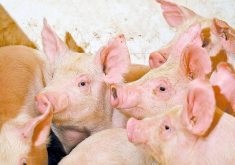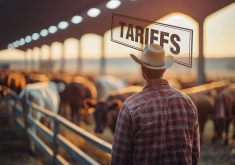Unique Manitoba rancher uses a skidsteer and method of his own design to feed bagged silage
Ken Vaags would put a short-order cook to shame.
The Dugald, Man. rancher uses his skidsteer loader and a specially designed self-feeder that controls access to a huge bag of silage. Two rollers operated by a hand crank wind up the top and bottom lips of the bag, while bars in front create a manger that minimizes waste. A polywire electric fence prevents cattle from trampling the bag, and all Vaags has to do is push the whole contraption about 18 inches towards the bag with the skidsteer.
Read Also

Horns aren’t unlocking anytime soon on livestock transport standards
Standards good enough meet the definition of “humane” animal transportation still vary widely between what what industry wants, what animal rights advocates want and, between the two, what federal regulators decide is good enough.
“It takes me less than four minutes to feed about 5,000 pounds of silage,” said Vaags.
As a part-time rancher, Vaags needs to keep the amount of time spent looking after his 315-head herd to a minimum. With that in mind, he keeps the bulls in a pen, and runs all the cows, steers and heifers together in one herd to save time.
“It’s not the number of cattle that takes the time, it’s the number of groups of cattle,” he said, adding that his winter chores take about two hours a day.
He uses a two-day feeding cycle that costs about $290 per day for the whole herd, not counting salt blocks or the 10 litres of diesel that go into the skidsteer each day.
On Day 1, they eat bagged silage with a 125 relative feed value and 16 to 18 per cent protein. On Day 2, they get timothy or meadow fescue straw that Vaags bales in the fields of local grass seed growers.
Some ranchers say silage is too expensive to feed, but not Vaags. He figures a 250-foot bag of alfalfa silage costs $2,500 to fill, or roughly two cents per pound of dry matter for chopping, hauling, bagging and the cost of the bag, plus another cent per pound to grow it.
No grain is fed to his cattle, ever, because his final product is pitched to his customers as “grass-marbled” beef that is delicious and tender.
“That’s a rule because I want to be able to say with a straight face to people buying my beef that this animal has never eaten a kernel of grain in its life,” said Vaags.
Genetics, feed quality, markets, human resources, and land quality have to work together to make a successful beef operation, said Vaags.
“It’s how your parts fit together that make you profitable, not that you have good parts,” he said.
Alfalfa is the “key resource” on his ranch, and without it, he’d have to change almost everything he does.
Cows go on grass by the end of April, and then onto alfalfa pasture from June 1 until well into the fall. Most years he keeps them on stockpiled or third-cut alfalfa up until Nov. 15, but this year, lack of rain in August meant they were off pasture by mid-October.
He uses a leader-follower system on his alfalfa-grass pastures, with finishing steers and yearling heifers leading, and cow-calf pairs following.
After taking the plunge into grazing alfalfa more than a decade ago, he saw his share of “bloat storms” until he learned to wait until the plants are in flower.
“When they are leading on those juicy tops, they do extremely well,” said Vaags.
Instead of obsessing with notions about the advantages of big versus small cows, Vaags avoids the stereotypes altogether and opts for what he calls “designer cows” — ones with good fertility, able to easily calve, and consistently able to maintain body condition. To improve his meat-to-bone ratio and flank width, he has added a Gelbvieh bull.
Calving begins April 20, and the calves stay on the cows until March 10. His herd’s production exceeds the market for direct sales of his grass-finished beef, so he opts to sell 650-pound calves at 10 months of age. Most of his females are sold as bred stock capable of producing grass-finished steers.
“I don’t believe in making hay in southeastern Manitoba,” said Vaags, who favours out-of-the-box thinking when it comes to raising beef.
“In my country, you can’t afford to make hay. You get one rain on a good crop and you lose about one-third of the tonnage and one-third of the feed value.”
Vaags moves his winter feeding sites each year so he doesn’t have to spend time or money scooping up the manure and hauling it elsewhere. Open-field feeding requires windbreaks, which he positions each day based on that morning’s weather forecast.
A special bracket welded onto each that fits his skidsteer’s loader makes the job easy, and by chaining them together, he can avoid having them fall over in a stiff wind. Water is provided from an insulated concrete trough.
A video of his silage-feeding system can be found by Googling “self-feeding silage bag demonstration.”














